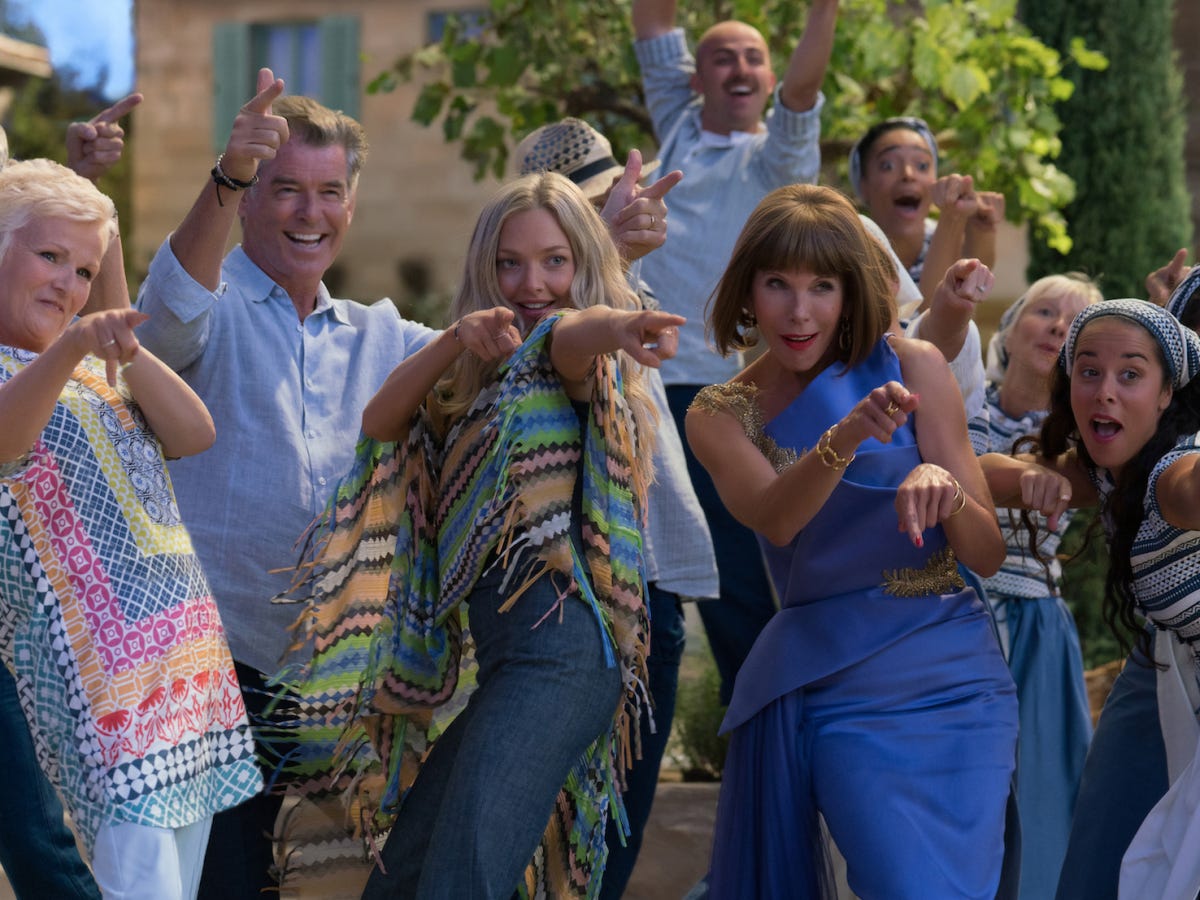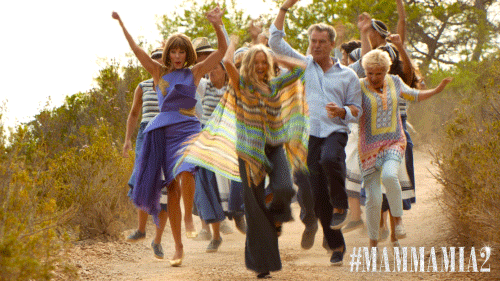The Ending of 'Mamma Mia 2' Needs to Be Studied
The perfect film ending does exist and it features glitter, feather boas & Colin Firth improv.

A funny thing happened in a small Brooklyn Heights movie theater a few summers back.
The film Mamma Mia! Here We Go Again was starting to wrap up and credits were about to roll, usually a cue for popcorn boxes to be collected and limbs to begin lazily stretching in the air. Instead, a knock-out, balls to the wall, chaotic musical sequence burst onto the screen, stopping all of us in our tracks. What followed can only be described as a full-on delirious frenzy. People were clapping along hard, people were scream laughing — even harder — and my face threatened to split in two from smiling with such pure, maniacal glee.
The last four minutes and eleven seconds of Mamma Mia 2 are a master class in not only how to create a perfect cinematic ending — but in the art of movie-making in general. With streaming services reigning supreme and breakaway big-screen hits so few and far between, I would challenge any powerful studio head to study this credit sequence in a quest to bring the joy, magic, and good old-fashioned rapture back to the theater-going experience.
Yes, I understand why this pitch may sound insane.
And yes, I should be transparent: this is coming from a fan who watched the sequel *twice* on a plane over the course of a single trip.
With that out of the way, let’s proceed.
First, a quick recap for those who haven’t been re-watching Mamma Mia 2 with quite as much of a frequency. The musical, which exclusively features ABBA songs, follows Sophie (Amanda Seyfried) as she prepares for the opening of her newly renovated Greek hotel, which she inherited from her late mother Donna (Meryl Streep). As we follow Sophie’s story, the film flashes back on Donna’s first arrival to Greece, while chronicling three of her young romances along the way. The movie’s last moments bring the entire cast together — adorned in matching sparkly sequin bell bottoms — for a performance of “Super Trooper.”
In that final sequence, Meryl Streep is inexplicably back from the dead and reunited with her beau, Pierce Brosnan, transcending time and space with their love. We have no questions, only warm feelings. The younger versions of each of the characters and their older versions unite to dance together. It’s very satisfying. Cher’s hair encircles her head in a white puffy cloud as she performs in front of adoring extras. She is captivating.
Those four-ish minutes manage to deliver that very specific drug of a Broadway musical curtain call, when all the actors are half in and half out of character, belting to the back of the house, taking their bows, dancing and beaming as the audience is swept onto their feet to dance and clap along with them.
Part of the ending’s miraculous success is the looseness and spontaneity with which it was shot. Vulture revealed in an excellent oral history that the actors were given the agency to perform exactly how they wanted to perform, teaming up in the best theater camp-like way to choreograph their own bits. “Neither Julie [Walters] or I are dancers at all,” Alexa Davies, who played young Rosy, shared. “So we came up with this little dance where it felt very Rosy and was a lot of silly, easy movements. It was literally like, sing to each other, turn back to back, shimmy, turn back, point at each other. And we’re like, ‘That’s perfect. Let’s sit down. Do you want a cup of tea? I want a cup of tea.’”
Brosnan improvised the bit where he tosses his microphone in the air and then, entirely by accident, catches it the wrong way. That stayed in the final cut. Colin Firth very politely declared that he did not feel comfortable dancing, so his younger counterpart, Hugh Skinner, was instructed to just dance around him. (“Oh God,” Skinner told Vulture, looking back on that moment. “I genuinely felt awkward.”) Stellan Skarsgård and Josh Dylan didn’t “know what the fuck to do” and came up with some haphazard moves, which Skarsgård promptly forgot multiple times on-camera.
All this to say, looseness and surprises on-screen — tucked within the confines of great scripted material — can make for a special, all-too-rare cinematic experience. Part of the reason TV comedy staples like The Office and Curb Your Enthusiasm remain such enjoyable rewatches is because the actors were given the agency to find their own moments of humor and realism within the script. Not every scene needs to move the script forward. Funny is funny. There’s always room — within reason! — for those random, weird moments that catch you off-guard.
Take Judd Apatow. He remains one of those rare filmmakers who has managed to bridge the gap between delivering a specific brand of loose realism to both television and film. His 1999 cult hit TV show Freaks and Geeks was littered with rough-around-the-edges moments that weren’t scripted, creating a joyfully realistic depiction of teenage life. Moments that would normally be edited out — an actor accidentally tripping or a bit of snot blowing out of an actress’s nose when she cackled too loudly — were lovingly kept in. He brought those jagged edges to movies of the early aughts, like Superbad and The 40-Year-Old Virgin, and created a startlingly different kind of movie going experience. Suddenly, audiences were a little bit more on their toes. The jokes felt funnier, fresher and realer. It became more of a deliciously risky moviegoing experience.
Which brings me back to Mamma Mia 2. Yes, the ending is wonderful because it’s just so damn fun and sparkly and jubilant. But it’s also unapologetically quirky and lives outside the world of a tightly scripted, painstakingly structured film. It’s the thrill of live theater. It’s the excitement of taking a risk with your audience. It makes paying an insane ticket price worthwhile. And it allows you feel, for a moment, like you’re a part of it all — that, much like Donna and the Dynamos once sang, somewhere in the crowd is you.
Reminder! Join us for our weekly Severance chat on Sunday, Feb. 1 at 9 PM ET.
The Ministry Recommends Our Favorite Substack Read of the Week…
Jennifer: I've long been a fan of
' TV criticism for NPR. I'm picky about criticism, but he always delivers insightful opinions that take into consideration both the social climate at large and the history of the medium. With the crumbling of traditional media, we're seeing more journalists flock to Substack to either supplement or supplant their mainstream work, speaking more directly to their readers. In fact, that's what we did here in starting the Ministry, and we're thrilled to see the likes of here as well.I love what he did in his recent post about Questlove's excellent and buzzy documentary about Saturday Night Live's 50 years of musical guests, weaving together his love for the film with his personal experiences on the set of SNL. He even shares a story from 1994 that he wrote for Modern Drummer magazine (!) about Shawn Pelton, the drummer for the house band. "Like a lot of things in SNL’s present, the musical performances may have lost a bit of their groundbreaking quality," @ericdeggans writes. "But by allowing the most talented performers space to perform on live television every week, SNL provides the intoxicating possibility that, just possibly, next week will bring another banger."
Kirthana: As someone with a novel coming out in two months, I'm a big fan of
's smart publicity advice. Especially this beautiful essay, which points out how so much of our communication can be boiled down to internet lingo and quick-hit inside jokes. "It’s a reliance on the bit, the shorthand—which perhaps makes folks feel in-community with one another in the quickest possible way without sharing any true vulnerability—at the expense of that vulnerability entirely," she says. She advocates for more depth and substance to create more meaningful connections. In other words, "let's be long about it."Erin:
and of the newsletter are doing the Lord's work. They noticed that Barnes and Noble is randomly selling a Pedro Pascal fan magazine and embarked on an investigation into the matter. Their account is a joy to read. Yes to joy! Yes to Pedro Pascal! Thank you for your service, ladies.Thea: I just discovered
, founded by Amelia Wilson, and I’m so glad I did. Amelia has created a smart, playful, deliciously well-written newsletter about finding the joys in everyday life. I loved her recent essay about breaking free from constant career ruts and her challenging, illuminating journey to becoming a writer.Saul:
is the author of one of my favorite books about comedy, "Poking a Dead Frog," and a regular contributor of terrific interviews to The New Yorker. So I was very excited to see that Sacks has joined Substack (his site is called Sub-Sacks, obviously), and has launched by sharing an interview cut from "Poking a Dead Frog" with writer Josh Alan Friedman. I can't wait to see what Sacks does next.





This scene is the epitome of pure movie joy! And I love the point you make that a major reason why it works is that it let the actors come up with things on the fly.
I am ashamed to admit I've never seen either "Mamma Mia" movie, but have been convinced that I have to make up for that gap in my cinematic education!